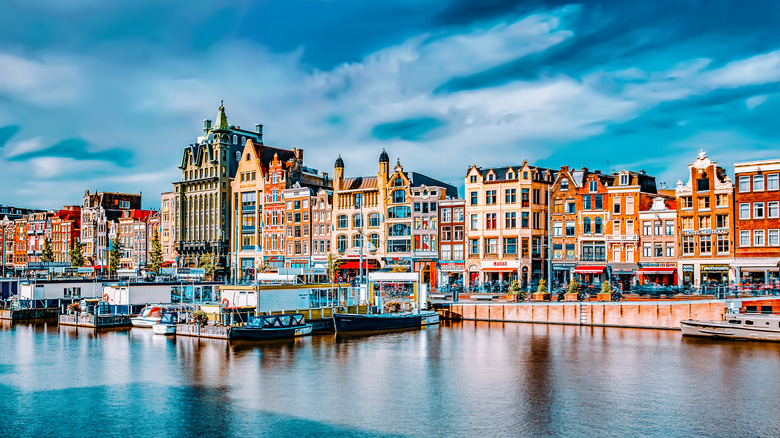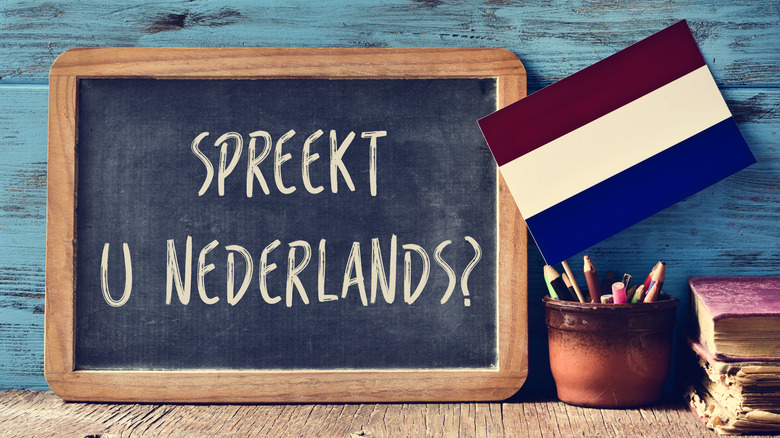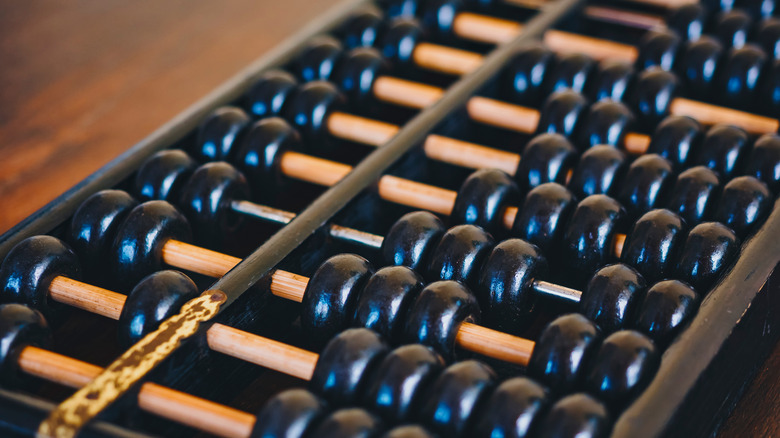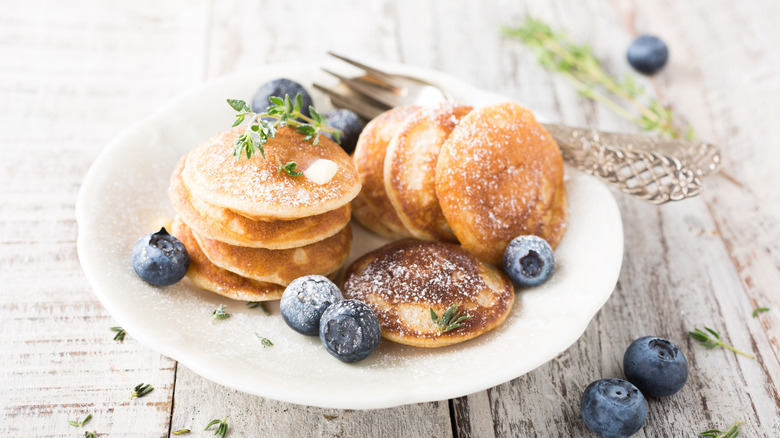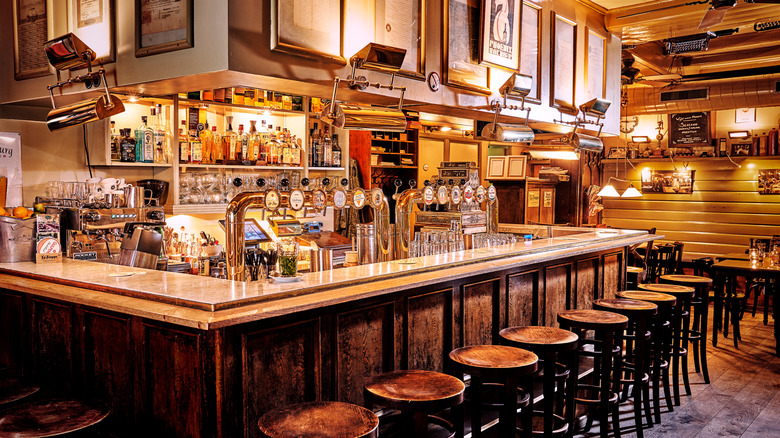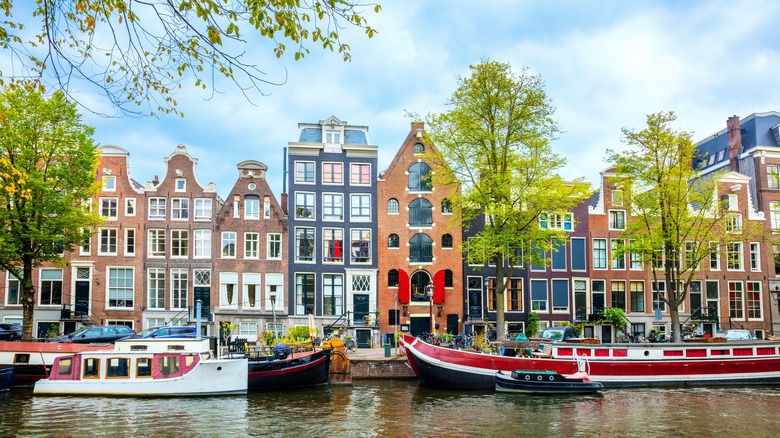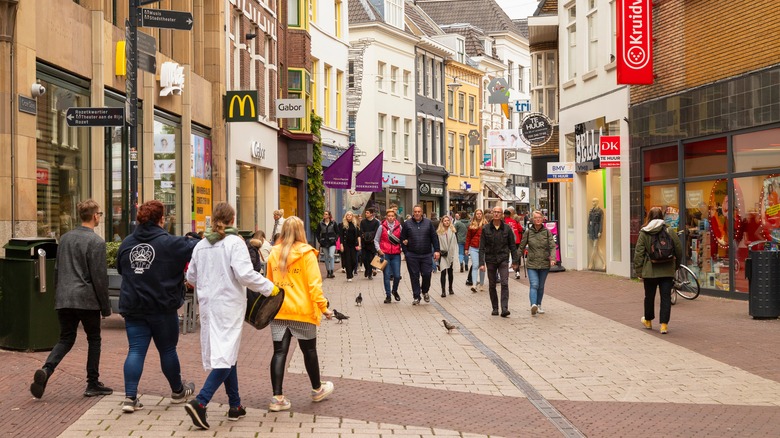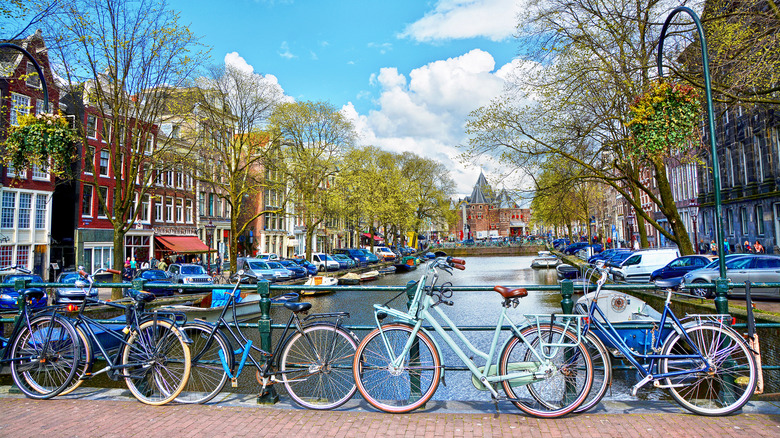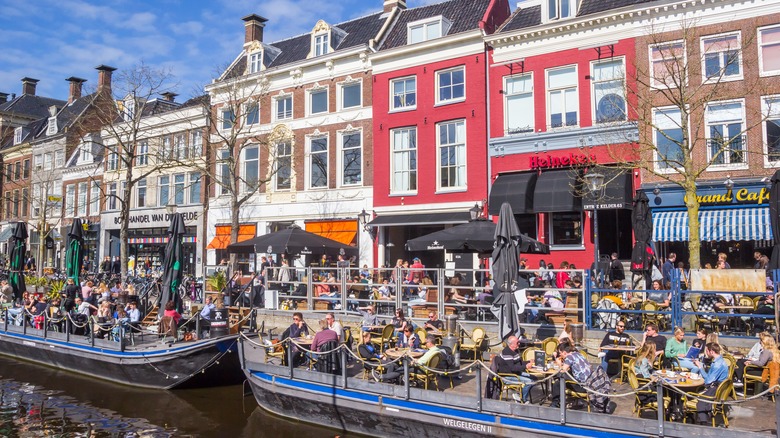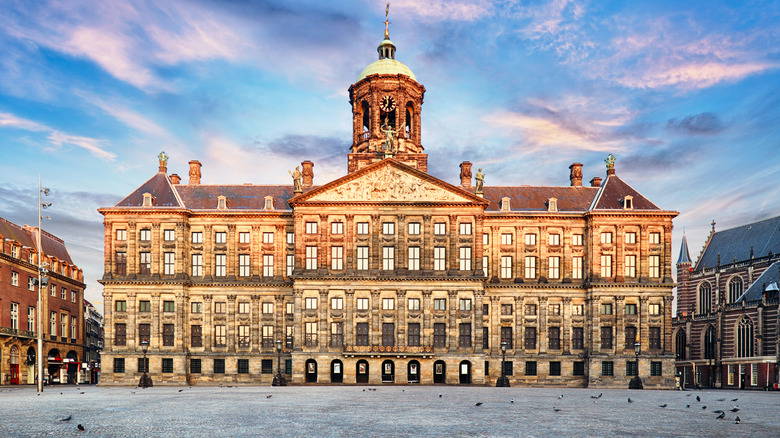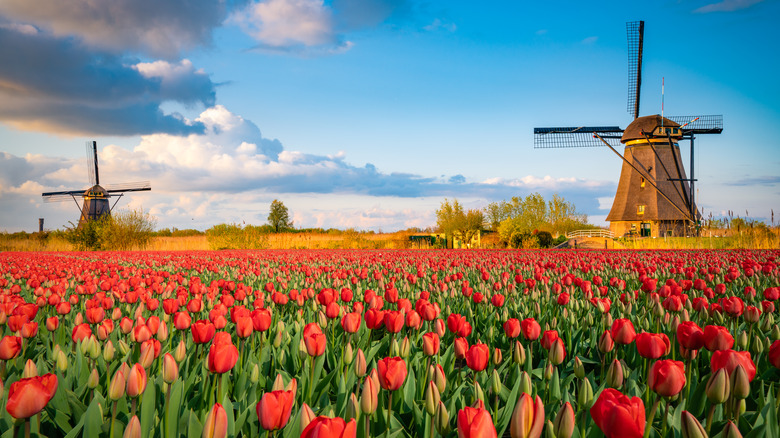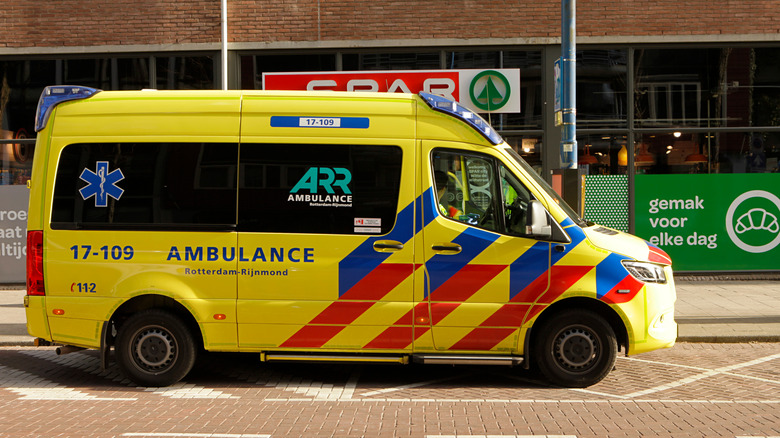Essential Words And Phrases To Know Before Your Trip To The Netherlands
Spoken throughout the Netherlands and in parts of Belgium (it's one of Belgium's official languages), as well as countries in South America, the Caribbean, and a variant of it in parts of Africa, Dutch is a language with roots in German. Its name derives from the word Duutsc, a term used in Medieval times to describe a widely spoke vernacular, and while most English speakers will think of Dutch being the language spoken in the Netherlands, it is officially known there as Nederland/Nederlands.
The idiom varies from region to region within the country, but the standard Dutch that everyone learns in school in the Netherlands is universally understood, and is the most logical version to take up. It is an undeniable truth that most Dutch people speak excellent English (sometimes even better than native English speakers!), and you can certainly get by communicating with everyone in the Netherlands in English. But that's no reason not to learn some basics of the language. After all, it will help you have a richer experience in the country when visiting, and maybe even help you decipher signs, notices, menus, and more. Here are some essential pieces of the language that will ease you into a trip to the Netherlands or further afield in the Dutch-speaking world.
The basics
At times, Dutch can almost sound like German, but throw in some of the more unique aspects of the language, and it diverges from the language spoken by its easterly neighbor. German is precise and clipped, Dutch is more alive, with animation in the mouth of the speaker and in the timbre of the language. The Dutch use a wide range of sounds when speaking, and different parts of the mouth help to shape various letter construction, and this can throw non-native speakers. But with a little practice, native English speakers can easily navigate the pronunciation of Dutch words, even the trickier sounds.
The most difficult bit might be the guttural sound needed to pronounce the letters "ch" or "g," which happens in the back of the mouth (it's a little like the "j" in Spanish) — an example would be "goed" for "good", pronounced like a breathy "hood" but with a bit more raspiness, or "lachen," meaning "to laugh." The letter "w" comes out like a mash-up of "w" and "v" in Dutch, the "v" ends up sounding more like an "f," while "sch" is a hard sound (like in the English word "scheme"). The letter "j" sounds like a "y," so the name "Jaap" would be pronounced "Yaap," but after the letters "c" or "s" its sound changes to that of an "h," so "sjall" for "shawl" is pronounced "shall." For other letters, the approximate sound in English usually works.
Numbers game
Anyone that has studied German might recognize similarities between the numbers in that language and those in Dutch. Being able to quickly pull a number from your head will pay dividends, even if writing it down in digits is vastly easier. The numbers from 1-10 are "één" (the accents signify the need for stress, but going forward, we will leave them out for ease of reference), "twee," "drie," "vier," "vijf," "zes," "zeven" (that's an easy one!), "acht," "negen," and "tien" ("zero" is "nul", by the way). The next set of 10 starts from "elf" for "11," before continuing on to numbers that sound a little similar to those in English — "twaalf," "dertien," "veertien," "vijftien," "zestien," "zeventien," "achttien," "negentien," and "twintig."
For multiples of 10, the ending "-tig" is preceded by the corresponding 1-10 number: "dertig" (for "30"), "veertig," "vijftig," "zestig," "zeventig," "tachtig" (notice the slight difference for this number, "80", with "tacht", not "acht" before the "tig"), and "negentig." The number "100" is denoted by "honderd." To add numbers together is simple — just add the word "en" (or "and") between the numbers you want to lump together. For numbers less than 100, such as 54 as an example, the "4" will come before the "50," so it would be written/spoken as "vierenvifjtig." When you include 100s, the hundred number comes first, followed by the above construction for tens and ones — so "245" is "tweehonderdvijfenveertig."
Starter pack
A few simple phrases that can be used day-in, day-out, will help you get familiar with the language, boost your confidence using it, and also help you to connect with the Dutch people you will encounter on the trip. The introductory "hello" can be as easy as a "hoi,", or "hallo," while "goodbye" is said as "tot ziens" (when "-ie" appear together in Dutch, the pronunciation is more akin to a compact "-ee"). "Yes" and "no" are "ja" and "nee," while "good" and "bad" translate to "goed" and "slecht" (time to enunciate that guttural "-ch"). These two will be useful (though hopefully the former, not the latter), when someone asks "hoe gaat het met u?" or "how are you?" (sometimes shortened to "hoe gaat het?").
If you need something to eat, you can try "ik heb honger" (yes, it does sound a little like "I have hunger"), or "ik heb dorst" when thirst strikes. When you find yourself really struggling to be understood in your basic Dutch, try "ik spreek niet zo goed Nederlands", telling someone that you "don't speak Dutch very well," and perhaps ask them "spreekt u Engels?" or "do you speak English?"
Greetings earthling
Just like at home, when we are surrounded by the places and people that we are familiar with, pleasantries are key moments in daily life, used to acknowledge and interact with those around you in a friendly, inclusive manner. Think of those phrases as serving the same purpose when on vacation anywhere, and if you are bold, you can even use them on total strangers as a way to feel more aligned to the local environment. Begin the day with a "goedmorgen," or "good morning," and as the hours progress, that will change to "goedmiddag," or "good afternoon."
As night falls and the day winds to its conclusion, visitors can use "goedenavond" for "good evening," and "goedenacht," or "good night." Remember the "g" at the beginning will have a guttural sound, not like the English hard "g" used in the word "good," but more like a plosive "ch," as in "chorus". If someone says "hoe heet u?" they are asking your name, to which the reply would be "ik heet" followed by your name. If you enjoy meeting someone, tell them so by saying "aangenaam kennis te makan," or "nice to meet you." Sounds like the start of a great friendship.
Giving thanks
It's important to be cordial, especially so when you are the guest of another country, after all, as the old English saying goes, "manners maketh man." The most obvious words to learn are "please" and "thank you," which are "alstublieft" and "dank u wel" (you might also see or hear "alsjeblieft" and "dankjewel," which are less formal ways of saying the same thing, using the informal second-person pronoun "je" instead of the formal "u").
If someone thanks you, and you wish to accept the gratitude with equanimity, reply with "graag gedaan," or "you're welcome" (a great phrase for working on that raspy "g" sound). If you bump into someone by accident, or need to apologize, travelers will have no difficulty remembering the word "sorry," which has the same meaning in Dutch and English. You can also express cheers with "veel success," or "good luck," or caution with "wees voorzichtig" (meaning "be careful").
Making a meal of it
It's handy for visitors to know a few restaurant-specific terms for the times that they eat out — and inevitably they will at some point during a trip to the Netherlands. The word for "restaurant" in Dutch is the same as in English, though the "r" sound is rolled more in Dutch. Once seated, you might ask to see "de menukaart" ("the menu"), to pick items like a "voorgerechten" ("appetizer"), or "hoofdgerecht" (for a "main course), or even a "nagerecht", a "dessert." Once you have finished, you will need to ask, rather ominously, for "de rekening" — no, this isn't a signal for your impending doom, but instead the word for "the check."
Of course, during the meal, you might need to use the restroom, and in this case lead with "waar zijn de wc's," or "waar zijn de toiletten." Dutch food is anchored by the trifecta of bread, cheese, and meat, so for vegetarians needing to find something they can eat, ask "heb u vegetarisch eten?", or "do you have vegetarian food?" The word for "vegan," either as a noun or adjective, is "veganistisch." If you find the food to your liking, consider telling the waitstaff that it is "lekker," or "tasty."
Raise a glass
The Dutch love their beer, especially in an atmospheric "bruin café" or "bruine kroeg" (literally "brown cafe" or "brown pub"), which can be found across the country — it refers to an old, wood-paneled place that smacks of deep history and fascinating stories. It's the kind of place filled with regulars, and where the Dutch love to catch up with friends or colleagues over a tipple. Beer is synonymous with these places — the Netherlands, after all, is home to Amstel, Grolsch, and Heineken. When you go into a bar, rather than choose a particular, artisanal, hand-crafted, small-batch IPA brewed in a micro-brewery that resides in a former industrial part of the city, simply ask for "een bier" and take what the server pours you from the tap.
You might hear the word "proost" in a bar, this simply means "cheers," so consider using it at any opportune moment. For spirits, the Dutch are fans of jenever, a drink that is made from "genever" (the Dutch for "juniper"), but is much more complex and full-bodied than gin. Definitely order one by saying "een glaasje jenever" (notice the "-je" at the end of the word for glass, more on that later).
Pounding the pavement
Revise a few directional words and phrases for when you are out exploring a city, town, village, or the countryside, and it will make getting lost a lot less stressful. A key construction is "waar is," or "where is," that you can put in front of things like "de bushalte" ("bus stop"), "treinstation" (pretty self-explanatory), "kanaalboot" ("canal boat", especially useful in Amsterdam), and "taxistandplaats" ("taxi stand").
Directions break down as "links, rechts, voor, achter," or "left, right, in front, behind," though the Dutch add "-af" afterward to denote movement, so "linksaf" to "go left." If you really are lost, tell someone that "ik ben verdwaald," or that "I am lost," and hopefully they will be able to give you directions using some of the words above that will help you to reorientate yourself. A few other useful words that will let you get your bearings are "de hoek," or "the corner," "de rotonde," for "the roundabout," and "het stoplicht" for "the traffic light."
Shopping list
Undoubtedly you'll be buying items in the Netherlands, either in a supermarket ("supermarkt" in Dutch) or other store, so a few phrases will recur, and learning them will make the purchasing process proceed a lot more smoothly. When you walk into a store, most likely a clothing or apparel store, somebody might ask "kan ik u helpen?" or whether they "can help you?" — and the easiest response is "ik keek alleen even," or "I am just looking." You can also pre-empt that question by saying "kan ik even rondkijken," or "can I have a look round," upon walking into the shop. When looking for something specific, start with "ik heb" (for "I need") or "ik ben op zoek nar," meaning "I am in search of."
You can ask to try something on by the term "kan ik het even aandoen?" and if you need a different size, request "een andere maat," either "klein, gemiddelde, groot" ("small, medium, large"). At checkout (or "de kasso"), travelers can confirm that the store takes credit cards with "accepteert u credit cards?" In a supermarket, some of the basic items you might look for are "vlees, kaas, brood, melk, eieren, groenten," or "meat, cheese, bread, milk, eggs, vegetable," in parts of the store like the "vlees sectie" or "sectie produkt" (meat and produce sections).
Getting around
Moving around a destination will require that you brush up on your knowledge of transportation terms. The Dutch, of course, especially in Amsterdam, are famed for their devotion to bicycles, and some cyclists in the capital zip round the city with dizzying speed (so stay cautious when stepping off the sidewalk at all times if you don't want to get hit by the next Joop Zoetemelk, a famed Dutch cyclist).
You can rent "een fiets" (a bicycle) to emulate the popular method of local transportation, but be sure to wear "de helm," or "the helmet," when biking around town. Most likely you will arrive at "de luchthaven" ("the airport"), from where you can opt from a "taxi" (same word in English) or buy a "kaartje" ("ticket") for "openbaar vervoer" (or "public transportation") to your final destination. Be sure to get off at "de halte" ("the stop") that is closest to where you are going.
Insider information
The suffix "-je" is used by Dutch in a similar way that "-ito/-ita" is used by Spanish speakers. Yes, it's a diminutive, but when added to words, it doesn't really denote a reference to size of any sort, but actually it takes on the role of a marker of fondness. For instance, you might buy flowers for someone, but instead of saying "bloemen" (the actual word for "flowers"), you might use "bloementje," or "little flower," though not literally small in stature. Similarly, at a bar, a Dutch patron might order a "biertje," which means little beer, but will get a normal size beer (that said, beers are served in smaller glasses in the Netherlands than in the United States, but we digress).
This diminutive is used liberally by native Dutch speakers, but for newcomers to the language, stick to the normal format for a word, it's easier to remember. Furthermore, it's also easy to get the diminutive wrong, since the "-je" ending can appear as "-je," "-kje," "-pje," "-tje," and more, depending on the word that it completes — but if you feel like it, give the diminutive a shot.
Building knowledge
As you explore destinations in the Netherlands, you'll need to get to specific places, either historic sites, places of interest, or a specific store. We have covered terms for a restaurant, cafe, pub, airport, and some types of transportation, but you might need to find "the town hall," or "het gemeentehuis," or a "palace," which is "paleis" in Dutch. In town, as you wander the streets, finding "de bank" (easy to guess) to get some money will help you buy any essential supplies at "de apotheek," or "drug store."
Fans of ecclesiastical architecture can look for "de kerk" or "de kathedraal" ("the church" or "the cathedral"), and if you can't find either, head to the "VVV kantoor," or the "tourist office". If you want to communicate the old-fashioned way with loved ones back home, visit the "postkantoor" ("post office") to get some "postzegels" ("stamps") for your postcards. And if you need a little pick-me-up, drop by "de bakkerij" ("the bakery") for sweet, sugary treats like a gemberbolus, a ginger-inflected pastry.
Outward bound
While the Netherlands is a very flat country, with its highest point only about 1,000 feet above sea level, there are plenty of pretty rural areas to explore. As an aside, the country's flatness is one of the reasons that it's a great place to cycle around. The Dutch refer to the countryside as "platteland," which literally translates to "flat land," and it's here that you might find a "grot" ("cave"), "een berg" ("a mountain"), and a "boerderij," meaning a farm.
With a location along the North Sea, the Netherlands has plenty of "kust" ("coast"), where there are "baaien" ("bays"), "stranden" ("beaches"), and "schiereilanden," or "peninsulas". Of all the flowers on the planet, most travelers will associate the "tulp," or "tulip" with the Netherlands, with renowned, brightly colored rows of the bulbous flower on view at Keukenhof Tulip Gardens, an easy trip from Amsterdam. The most vibrant blooms occur in the Spring, from April to May.
Helping hand
Hopefully you will never need emergency assistance, but if you do, a few phrases will help those around you understand what you need. The easiest starting point is "help," which means the same in English, a universal cry for aid. To get someone to call the emergency number, say "bel een een twee," or "call 112," the Dutch equivalent of 911. The "police" are known as "politie" in the Netherlands, while the fire department is "brandweer." If you don't feel well, say "ik ben ziek" ("I feel sick/ill") and perhaps ask "haal een dokter" ("call for a doctor").
If you feel like you can make it to the hospital on your own steam, but don't know where it is, try "waar ist het ziekenhuis," and if you feel faint and need to hydrate, say "ik heb wat water nodig," or "I need some water." Finally, if you've been robbed, declare "iemand heeft mijn portemonnee/telefoon gestolen" ("someone has stolen my wallet/phone"), and of course notify the "politie."
